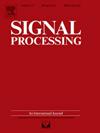Dual-function waveform optimization algorithm of joint transmitter and receiver via W-ADPM
IF 3.4
2区 工程技术
Q2 ENGINEERING, ELECTRICAL & ELECTRONIC
引用次数: 0
Abstract
This paper proposes a novel algorithm for joint transmitter and receiver dual-function radar communication (DFRC) systems based on orthogonal frequency division multiplexing (OFDM) waveforms. The algorithm achieves a better detection performance while containing communication bit error rate (BER) performance, modulating communication information into the phase of the OFDM waveform using M-phase-shift keying (MPSK) schemes such as Binary-PSK (BPSK) and Qinary-PSK (QPSK). Subsequently, the waveform minimizes the weighted peak sidelobe level (WPSL) of the transmit waveform and the receive mismatch filter while ensuring the bit error rate (BER) condition to reduce sidelobes. Additionally, constraints are placed on constant amplitude, BER, mainlobe energy, and signal-to-noise ratio (SNR) loss. This paper employs a Weight Alternating Direction Method of Penalty (W-ADPM) network-based approach to simultaneously optimize the transmit waveform and receive mismatched filters to address these issues, achieving the desired effect. The simulation experiments demonstrate that the proposed algorithm has better convergence performance for the DFRC OFDM waveform compared to the Alternating Direction Method of Multipliers (ADMM) algorithm. Besides, the simulation experiments show that, compared to traditional matched filters, the jointly transmitted and received mismatched filters proposed in this paper provide better ISL cross-correlation performance while ensuring the BER.
通过 W-ADPM 实现联合发射机和接收机的双功能波形优化算法
提出了一种基于正交频分复用(OFDM)波形的联合收发双功能雷达通信(DFRC)算法。该算法在保证通信误码率(BER)性能的同时,利用二进制- psk (BPSK)和十进制- psk (QPSK)等m相移键控(MPSK)方案将通信信息调制到OFDM波形的相位中,实现了较好的检测性能。随后,该波形在保证误码率(BER)条件下,使发射波形和接收不匹配滤波器的加权峰值旁瓣电平(WPSL)最小,以减少旁瓣。此外,还对恒幅值、误码率、主瓣能量和信噪比(SNR)损失进行了限制。本文采用基于加权交替方向惩罚法(W-ADPM)网络的方法,同时优化发射波形和接收不匹配滤波器,解决了这些问题,达到了预期的效果。仿真实验表明,与交替方向乘法器(ADMM)算法相比,该算法对DFRC OFDM波形具有更好的收敛性能。此外,仿真实验表明,与传统匹配滤波器相比,本文提出的联合收发失匹配滤波器在保证误码率的同时具有更好的ISL互相关性能。
本文章由计算机程序翻译,如有差异,请以英文原文为准。
求助全文
约1分钟内获得全文
求助全文
来源期刊

Signal Processing
工程技术-工程:电子与电气
CiteScore
9.20
自引率
9.10%
发文量
309
审稿时长
41 days
期刊介绍:
Signal Processing incorporates all aspects of the theory and practice of signal processing. It features original research work, tutorial and review articles, and accounts of practical developments. It is intended for a rapid dissemination of knowledge and experience to engineers and scientists working in the research, development or practical application of signal processing.
Subject areas covered by the journal include: Signal Theory; Stochastic Processes; Detection and Estimation; Spectral Analysis; Filtering; Signal Processing Systems; Software Developments; Image Processing; Pattern Recognition; Optical Signal Processing; Digital Signal Processing; Multi-dimensional Signal Processing; Communication Signal Processing; Biomedical Signal Processing; Geophysical and Astrophysical Signal Processing; Earth Resources Signal Processing; Acoustic and Vibration Signal Processing; Data Processing; Remote Sensing; Signal Processing Technology; Radar Signal Processing; Sonar Signal Processing; Industrial Applications; New Applications.
 求助内容:
求助内容: 应助结果提醒方式:
应助结果提醒方式:


